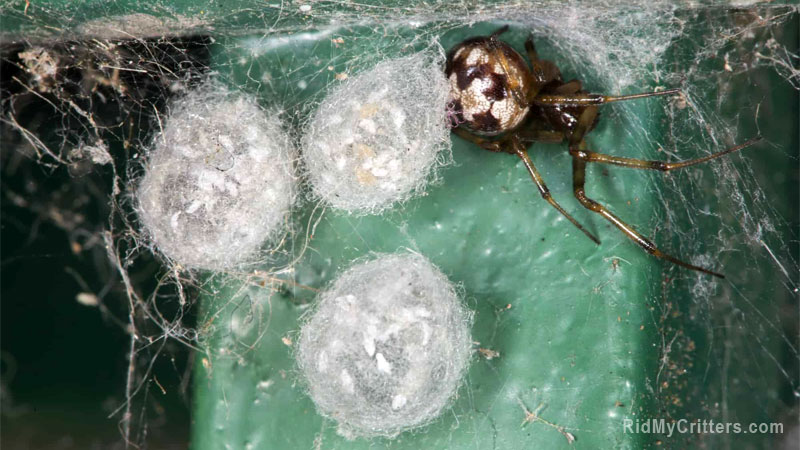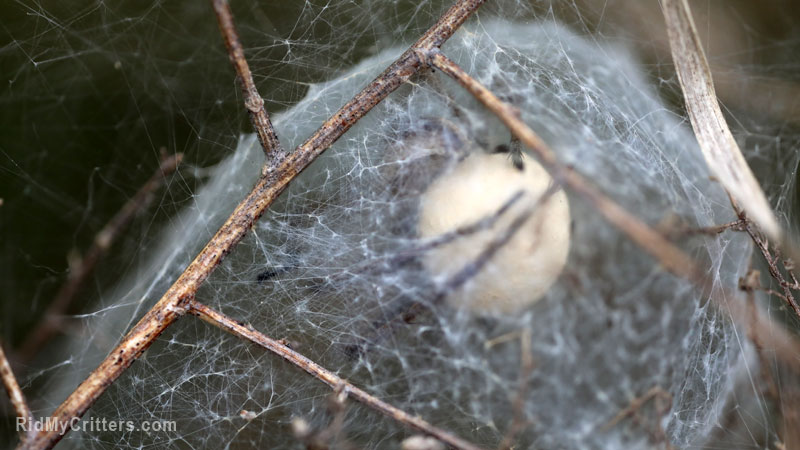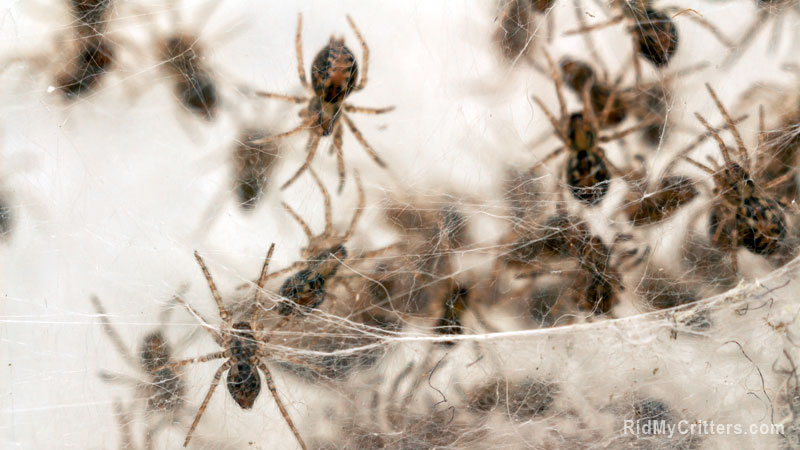You might already know how to get rid of spiders in the house, but what about the tiny spider egg sacs they leave behind? Come spring, you could be dealing with a sudden spider population numbering in the hundreds.
Thankfully, most of these baby spiders will die or move on, but plenty will stick around. Disposing of a spider nest when you see it will help reduce the risk of a sudden infestation. Keep reading to learn how to get rid of spider eggs the best way possible.
Identifying a Spider Egg Sac
Spider sacs or clutches are fairly easy to spot once you know what to look for. Unlike individual eggs which are usually too small to see, an egg sac is small but visible.
These silk sacs can vary from a disk-like shape to fully round, although teardrop shapes are common. Coloration also varies by species, with light to dark shades of brown, grey, or a creamy white.
The clutch is actually a thick netting of spider silk designed to insulate and protect the eggs while they incubate.
Related: How to Find a Spider In Your Room
Where Do Spiders Lay Their Clutches?
This depends largely upon the type of spider as well as where they’re located.
Outdoor Spiders
In the yard, Spider clutches are often located under organic debris such as fallen leaves and branches, in wood piles, or tucked into burrows. They may also build their nest under your eaves.
Some spiders will also lay their eggs on tree branches away from ground predators. Hunting spiders will often lay the clutch near a potential food source. Some, like the wolf spider, actually carry their egg sacs wherever they go.
See Also: 9 Fascinating Wolf Spider Facts
Indoor Spiders
Indoors, you’ll most likely find the eggs in a relatively unused place, such as your attic or basement. Some adult spiders will lay their clutch under furniture, especially if you don’t regularly clean under the couch.
In most cases, you’ll find the sac tied into a corner where it has the most protection. Thus the underside of a cabinet where there’s edging is a good place to spot them. They’re also often found in cardboard boxes.
Vehicles
Cars follow a similar rule to homes. The sacs will likely be in the engine compartment or trunk where it’s more insulated and away from human eyes. An RV or camper will have more places for the mother spider to hide her young, but even a motorcycle that hasn’t been used in a while can become an unwitting babysitter.
Clutch Types
Depending upon the species you’re dealing with, spider eggs will be clutched either in spider webs, suspended from a surface, or webbed directly into a corner.
They’re more likely to produce a clutch in an area where an edible insect (flies, mosquitoes, grasshoppers, etc.) population exists but less likely to be where predatory insects such as wasps or centipedes are found.
Be Wary of Imposters
Webs usually mean you’ve got spiders, but you might want to take a closer look if the webs are on your plants. Messy webbing between leaves could be an indicator that you actually have a spider mite infestation. You’ll usually find spider mite eggs in plant soil, but they’re too tiny to spot with the naked eye.
While spider mites are arachnids, they’re a type of mite and will require miticides or a neem oil treatment and likely won’t respond to methods aimed at spiders.
Just How Many Eggs does a Female Spider Produce?
Spiderlings (AKA newborn spiders) are very fragile and most don’t make it far from the sac upon hatching. As a result, a single spider has the ability to produce several hundred eggs at once. Let’s look at a few venomous species as an example.
A black widow spider will typically lay 300 eggs. Meanwhile, the brown widow lays 120 to 150 eggs per sac and is capable of leaving up to 20 sacs during its short lifetime. A hobo spider on the other hand produces up to four egg cases with each case holding 50-100 eggs.
What Happens When the Eggs Hatch?
Spider egg sacs are designed to protect throughout the incubation period, which may last only a few weeks or an entire winter, depending upon the species of spider. Upon hatching, the clutch of spiderlings break through the sac. At this point, they’re tiny and pale to almost translucent. They also move with incredible speed for their size.
Related: Where Do Spiders Go in the Winter?
In most cases, the spiderlings will disperse by ballooning. They migrate to a high point and create a little silk parachute, then jump into the wind. If you remember the ending to Charlotte’s Web, this was what Charlotte’s children were doing at the end.
It takes about a year and several moltings for the spiderlings to fully mature, during which time most will be killed or eaten. However, any spiders still in your home when they mature will mate and further increase the spider infestation.
See Also: What Does a Baby Spider Look Like?
How to Get Rid of Spider Eggs
The knee-jerk reaction when spotting a clutch is to squish it. This can be a mistake, as some species develop faster than others and you could easily end up with a hundred or more tiny spiders raining down on you.
Instead of stepping on an egg, try these methods instead for some safe ways to get rid of spider sacs.
Protective Gear
First things first. You should prepare yourself in case the sac belongs to a venomous species. Wear long sleeves and pants as well as work gloves so any spiderlings that hatch during removal can’t bite you. Protective clothing might not seem important if you know you’re dealing with a non-venomous spider species. However, it’s best to play it safe in case a dangerous spider species has been living undetected in your home.
Always use tools that have an extension so you aren’t in harm’s way if the sac breaks. Also, as mentioned, be sure to avoid squishing or breaking open the sac, as this can release the contents all over the room.
Bleach
An all-around useful cleaning product, bleach is safer than the average pesticide and will quickly destroy spider eggs.
Simply dilute some bleach with water in a spray bottle and squirt each spider egg sac you find. Be warned that bleach will generally ruin any item that has color unless it’s specifically formulated to be color-safe. This not only includes fabric, it can also affect some wood stains, paint, or wallpaper, so use this method responsibly.
Pest Pals
Some pests, such as centipedes, actually prey on spiders. These spider killers will actively seek out spider nests and destroy them. They also help against other insects. Of course, there are far cuter critters such as lizards that can do the same job and make good pets.
Pesticides
Various pest control products are designed to kill spider eggs. Try to pick an oil-based product that breaks down the webbing and soft-bodied spiderlings quickly. Some products will remain effective for up to a couple months, preventing additional attempts to lay eggs in that spot.
One of the best spider killer sprays is Miss Muffet’s Revenge. Not only does it have a great name, it kills spiders and their eggs quickly, repelling them for up to 12 months. A good odorless spider egg killer option is Harris Spider Killer.
As always, be very careful when using any type of poison, be it a spray or chemical spider traps, as they may harm beneficial species or come into contact with people and pets.
Vacuum
Your vacuum cleaner is often your best friend in pest control, especially if you have a steamer. You can use the vacuum to suck up spider eggs (even if they break open, the spiderlings will be contained), then dispose of the bag in the trash immediately after.
You may also freeze the bag first to ensure any hatchlings are killed if you believe the sac belongs to a deadly species such as the brown recluse spider. In the event you have a canister vac, be sure to empty it carefully or submerge the canister in a bucket of soapy water to kill any spiders that hatch before dumping.
- How to Get Rid of Hawks - March 8, 2024
- How to Get Rid of Pill Bugs (Rolly Pollies) - March 1, 2024
- How to Get Rid of Groundhogs (Woodchucks) - February 5, 2024


 Just tell me how to get rid of ’em.
Just tell me how to get rid of ’em.

I have pine inside my whole house. We also have a wood fire stove , sitting on granite slabs, I am super clean and hate bugs, and for 38 years we have never had any problems inside that I could see. This past year my husband bought Tamarack wood for the first time, and I have been going crazy. I noticed that there were some kind of little sparkly things on my floors, that turned into white eggs, I was picking them up with a Kleenex put them in the toilet and they would turn black? But the ones that I missed already hatched and some were round hard shelled dots, then got bigger and look like a kite. They go on my Shih Tzu and she is scratching like crazy. I have had them in my hair and I feel like I am going crazy. My husband said that they are nothing but I think he is wrong. I don’t know what to do about this I have vacuumed up to 3 times a day and I wash with bleach, and sprayed with Home Defence and another product from the store. If you have any suggestions please let me know I really would appreciate it thank you.
You might have to just call the exterminater. I did when I had fleas. It took 3 sprays of their solution to fix it but with these eggs they should have the equipment to really get rid of them. Hopes it helped
Oh my gosh I have the same problem and it is driving me insane. They look like glitter then black or brown in tissue. They are under my skin and feel like shards of glass. Please say you have discovered a solution to get rid. I beg you reply. Thanks. Danielle
lol
What’s the spider in the photo at the top of the page
I believe it’s a cavity spider (Nesticus cellulanus) most common in parts of Europe. Link
How do you get rid of a spider egg/ cocoon in a garage. If I squish it in winter will they come out? It’s an insulated garage. What spray kills them inside the egg sac so they don’t come out.
Squishing it isn’t the best idea as they are so tiny, they’ll simply all come out if they’re close to hatching. Just spray and soak it with a pesticide of your choice (a wasp/yellow jacket spray that shoots far is great for far away, hard to reach areas) or add a small amount of bleach to the egg sac so it soaks all the way through.
Is there any danger in not being able to find the egg sac if it has already hatched? There has been hundreds of tiny spiders in my flat and I’ve been killing/disposing as many as I can find, but still haven’t found the egg sac. There are lots of gaps/holes around the flat so I’m worried I may not find it. Is that okay if it’s already hatched, or do I need to get an exterminator?
Thanks 🙂